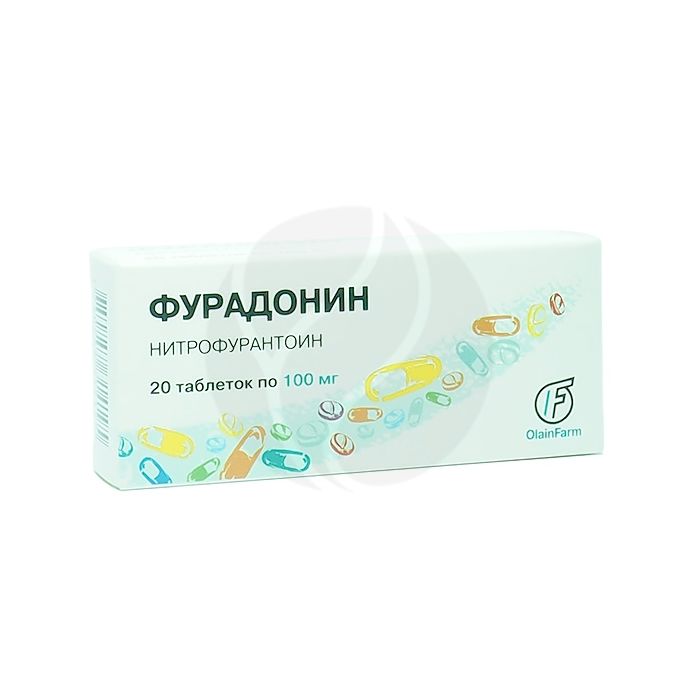Furadonin tablets 100mg, No. 20
Expiration Date: 05/2027
Russian Pharmacy name:
Фурадонин таблетки 100мг, №20
Infectious and inflammatory diseases of the urinary tract (including pyelonephritis, cystitis) caused by microorganisms sensitive to nitrofurantoin.
The dose for adults is 50-100 mg, the frequency of use is 4 times / day. The daily dose for children is 5-7 mg / kg in 4 divided doses. The duration of the course of treatment is 7 days. If necessary, it is possible to continue treatment for another 3 days (only after urine control for sterility). During long-term maintenance treatment, the dose of nitrofurantoin should be reduced.
nitrofurantoin
Severe violations of renal excretory function,
renal failure
oliguria,
deficiency of glucose-6-phosphate dehydrogenase,
pregnancy,
early childhood (up to 1 month),
hypersensitivity to nitrofurantoin,
heart failure stage II-III,
cirrhosis of the liver,
chronic hepatitis,
acute porphyria
lactation.
pharmachologic effect
Broad-spectrum antimicrobial agent, nitrofuran derivative. It has a bacteriostatic and bactericidal effect in urinary tract infections. Nitrofurantoin is active against Escherichia coli, Klebsiella spp., Enterobacter spp., Proteus spp. It is mainly effective for urinary tract infections.
Pharmacokinetics
It is well absorbed from the gastrointestinal tract. Bioavailability is 50% (food increases bioavailability). The absorption rate depends on the size of the crystals (the microcrystalline form is characterized by rapid solubility and absorption rate, a short time to reach Cmax in urine). Plasma protein binding - 60%. Metabolized in the liver and muscle tissue. T1 / 2 - 20-25 min. Penetrates the BBB, placental barrier, excreted in breast milk. It is excreted completely by the kidneys (30-50% - unchanged).
Side effect
From the respiratory system: chest pain, cough, shortness of breath, pulmonary infiltrates, eosinophilia, interstitial pneumonitis or fibrosis, decreased respiratory function, asthma attack in patients with a history of asthma. From the digestive system: discomfort in the epigastrium, anorexia, nausea, vomiting; rarely - hepatitis, cholestatic jaundice, abdominal pain, diarrhea. From the side of the central nervous system and peripheral nervous system: peripheral neuropathy, headache, nystagmus, dizziness, drowsiness. From the hematopoietic system: leukopenia, granulocytopenia, agranulocytosis, thrombocytopenia, hemolytic anemia, megaloblastic anemia (these changes are reversible). Allergic reactions: urticaria, Quincke's edema, pruritus, rash; very rarely - anaphylactic shock. Dermatological reactions:exfoliative dermatitis, erythema multiforme. Others: drug fever, arthralgia, flu-like symptoms are possible, superinfection of the genitourinary tract, often caused by Pseudomonas aeruginosa. Application during pregnancy and lactation Nitrofurantoin is contraindicated for use during pregnancy and lactation (breastfeeding).
Application for violations of liver function
Contraindicated in liver cirrhosis, chronic hepatitis.
Application for impaired renal function
Contraindicated in severe violations of renal excretory function, renal failure, oliguria. The risk of developing peripheral neuropathy increases in patients with severe renal failure.
Application in children
Contraindicated in early childhood (up to 1 month).
special instructions
The risk of developing peripheral neuropathy increases in patients with anemia, diabetes mellitus, electrolyte imbalance, deficiency of B vitamins, severe renal failure. Nitrofurantoin should not be used to treat diseases of the renal cortex, with purulent paranephritis and prostatitis. Nitrofurantoin is not prescribed in combination with drugs that cause renal impairment.
Drug interactions
The simultaneous use of nalidixic acid and antacids containing magnesium trisilicate reduces the antibacterial effect of nitrofurantoin. Nitrofurantoin is incompatible with fluoroquinolones. With the simultaneous use of drugs that block tubular secretion, reduce the antibacterial effect of nitrofurantoin (by reducing the concentration of nitrofurantoin in the urine) and increase its toxicity (the concentration in the blood increases).

